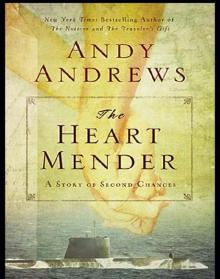- Home
- Andy Andrews
The Heart Mender Page 2
The Heart Mender Read online
Page 2
I next typed in Kriegsmarine buttons and was instantly rewarded. There, on my computer screen, was an enlargement, front and back view, of a button exactly like the eight in my possession. The front of the button proudly displayed the anchor while the magnification of the back side clearly revealed the word Kriegsmarine stamped in a semicircle. Remembering the letters I had barely made out on the back of the first button I found, I dug an old 8X photographer’s loupe out of my desk and looked at the back of one of the actual buttons. There it was, the same semicircular engraving of the same word that stared back at me from the computer.
As I moved my eye from the magnification device, I noticed that the photographer’s loupe—a small plastic piece with the brand name Lupe—had an engraving of its own. “Made in Germany,” it said. If it hadn’t been so weird, I would have laughed out loud.
The medal—easy to find—was an Iron Cross. First instituted by King Friedrich of Prussia in 1813, it was adopted as a piece of political imagery by Adolf Hitler during the opening hours of World War II and became the most recognizable decoration to be won by a member of the German military. The Iron Cross was awarded for bravery in the face of the enemy. The actual medal itself was seldom worn, but often carried. An Iron Cross recipient usually displayed only the brightly colored ribbon by running it out the top right buttonhole of his jacket. In the first photograph, I could see that very piece of red, white, and black cloth featured prominently on the Kriegsmariner’s uniform.
Next, I began a frustrating search for the silver anchor badge by typing in those exact words. After trying German silver anchor badge, German silver rope anchor badge, and German Navy silver rope anchor badge with no luck, I substituted the words pin and medal for badge, Nazi for German, Kriegsmarine for Navy, and every combination of those terms I could concoct, with the same results. Nothing.
Pausing for a moment, I sat back and stared at the badge/pin/medal/whatever on my desk. I had literally scanned the pictures of more than one hundred German decorations and military awards, but hadn’t come close to anything resembling this impressive piece of masculine jewelry. Picking it up, I placed the silver badge on the gray background of my laptop. Then, I saw something that, unbelievably, had escaped my attention. On the left side of the pin, from the anchor’s flange at the bottom to its cross bar at the top, rested a large U. Matching it on the right side was a B of equal dimension. Both letters appeared as mere decorative support, so I reassured myself I wasn’t a total idiot for having overlooked them. But now that I did see them, it was as if I could see nothing else—like the optical puzzles that, when you finally see the picture, you wonder how you could have ever missed it in the first place.
U B . . . I wondered. My eyes narrowed. U-boat? Immediately I typed in Kriegsmarine U-boat silver anchor badge and got the hit that led me to a picture of the badge in my possession. Subsequent searches using several different search engines finally gave me a fairly complete background on the medal.
Interestingly, it was commissioned by the German government in 1910 and worn at that time by officers in the submarine corps. For some reason, the Nazi regime chose not to include the medal in its official notices of recognition. Thus, I found that this particular design was worn by several U-boat officers during World War II as a deniable way of protesting Hitler and his policies. These officers, who either inherited the badge from a relative or had a copy made by a jeweler, considered themselves Germans, not Nazis—a curious but apparently not uncommon distinction.
The U-boat connection also led me to a picture and history of the ring. The engraving, Wir Fahren Gegen Engelland, translated “We sail against England.” Under close examination, again with the loupe, I could see a swastika in the eagle’s talons, all set on top of a tiny submarine, surrounded by a wreath. The written information about the ring was specific: it was worn only by an officer of the Unterseebootwaffe—the German submarine force. But who? The man in the first picture? And still the question lingered . . . why was it abandoned and buried here?
After I identified all the items, I turned my attention to the final photograph—the one with Hitler. Three additional officers appeared in the picture with the man most sane people still consider the sheer embodiment of evil. The officer standing immediately to the Führer’s left, pointing at something unseen, was in shadow, but by comparing pictures and searching Kriegsmarine files online, I soon identified him as Admiral Karl Doenitz, commander of Hitler’s U-boat fleet, later commander in chief of the Kriegsmarine.
I was never able to match a picture with the second officer who stands just behind and to the left of Doenitz or the third officer, of whom one can see only his head. I could only determine, with observational techniques honed by years of watching detective shows on television, that one of them seemed old and fat while the other appeared young and handsome.
“THIS IS A LITTLE GIRL.”
I looked up from my book. Polly was holding the picture of the man and woman with the baby in the wagon. Sitting at the other end of the couch with her feet in my lap, my wife had just stuffed another pillow behind her back and was drinking a cup of tea as she gazed at the photograph.
“What makes you think that?” I asked. Having attached little significance to that particular picture, I had given it a cursory examination at best and certainly had not attempted to guess the sex of the child. “Why do you say ‘girl’?”
She placed the cup on the small table beside her and sighed softly. “It just is. It’s a baby girl. The mom looks so sad.”
I was quiet. The boys were at their grandmother’s, and Polly and I were spending the weekend alone. It had rained constantly—a slow, foggy, winter drizzle that hangs on the coast sometimes for days. We had not turned on the television a single time, choosing instead to read or talk by the fireplace in our bedroom. The conversation had turned frequently to one or another of the items that had been buried under the old wax myrtle. Polly, for some reason, had taken the photograph with the child and used it as a bookmark. Several times, when she didn’t think I was looking, I caught her frowning as she stared at the simple, but somewhat odd, picture.
I had long ago learned to trust my wife’s intuition. Her perceptions about people, their feelings or intentions, were uncannily accurate. That is not to say I understood or always agreed completely with her conclusions; however, more than a few times I had been stunned by the precise detail she was able to discern.
I closed my book and eased it to the floor. Polly continued to hold the photograph, but stared out the rain-streaked window. “Dear,” I said softly. “What’s happening in that picture? Try to imagine it for me.”
She didn’t look at me, but pushed a lock of dark hair from her eyes and began to speak. “They are a family . . . a young family. The man and woman have been married a short time. This is their first child . . .” Polly cut her eyes at me. “And it is a girl. I don’t know why I’m so sure of that, but I am.” I nodded, urging her to continue.
“The man is the same man in the first photo . . . the guy in the uniform . . . so this is a picture that was made before he left for the war.” She paused and took a deep breath. “The woman is very sad . . . she’s scared. Her baby is less than a year old, and she doesn’t think they’ll ever see the man again.” Polly was quiet for a moment, then added, “I don’t think they did.”
IT RAINED FOR THE REST OF THE MORNING AND INTO THE afternoon. After lunch, I had gone to the dock alone and, under the covered area, lit one of the Mexican firepots. Warming my hands, I studied the blaze and reflected on Polly’s thoughts about the family in the photograph. Her words had left me unsettled. I couldn’t get any of it off my mind, and my work was beginning to suffer. I had already fielded several calls from my publisher and business manager about “the next book.” “How is the manuscript coming?” they wanted to know as the date of my next deadline was politely worked into the conversation. “Great,” I lied. “In fact, let me get off the phone and get back to work.”
In actuality, I hadn’t even begun. The two books I had been so excited about a week earlier had faded deeply into the recesses of the procrastination depot in my brain. The couple or three times I had attempted to write, my mind wandered so madly as to render my powers of concentration virtually nonexistent. Again and again, one basic question gnawed at me and refused to let go: How had all these items come to be hidden here, of all places?
Without warning, an idea of enormously obvious proportions popped into my mind. Why hadn’t I used the Internet to explore a possible connection between the Gulf of Mexico and the Kriegsmarine? Quickly I put out the fire while shaking my head at the awesome ability I seem to possess that allows me to overlook the apparent.
Moments later, in my office, I connected to Google and typed in German U-boats in Gulf of Mexico. Less than a second later, I was staring wide-eyed at the results of the search. There were 1,940 hits on the topic I’d requested. I couldn’t believe it.
I clicked on the first Web site and read the first sentence. It said, “During the years 1942 and 1943, a fleet of over twenty German U-boats cruised the Gulf of Mexico seeking to disrupt the vital flow of oil carried by tankers from U.S. ports.”
I swallowed hard and read the second sentence. “The U-boats succeeded in sending fifty-six vessels to the bottom; thirty-nine of these are in the state waters of Texas, Louisiana, and Florida.”
Furiously I clicked on site after site, each adding to or confirming the information of the last. In fact, the only discrepancy I could find was the number of merchant ships the U-boats sank. I was convinced, however, that the true number, depending upon which source I believed, was between fifty-six and sixty-two. And remember, those were only in the Gulf of Mexico.
Reading more, I was astounded to learn that when the Atlantic coast was included, only a handful of U-boats had sunk 397 ships—and that was in the first six months of 1942 alone! Eventually, before Hitler called them back, the U-boats destroyed more than 800 vessels in American waters. Unbelievably, many of those were within sight of people on the beach.
Cape Hatteras in North Carolina became known as “Torpedo Junction” as bodies and cargo began to float in. On May 4, 1942, sunbathers in Boca Raton, Florida, watched in horror as the U-564 surfaced and torpedoed the tanker Eclipse in broad daylight and in full view of the beach. The German submarine then turned and blasted the freighter Delisle and her cargo of camouflage paint. The subsequent explosions and shock waves rumbled over the panicked tourists on the beach with a deafening roar.
Explosions and burning wrecks, all along the eastern seaboard and Gulf coast, were regularly seen at night. Dead men, debris, and oil began to wash ashore, and still, America did not institute the blackouts that were in effect along the coasts of England and Germany. Even when the merchant ships turned out their own lights, the U-boats had only to surface and use the background of the U.S. coastline— whose lights could be seen for more than twenty-five miles—to target the huge vessels.
What was the cost in lives? I wondered. The answer was easily found. During less than a two-year period, more than 1,300 navy men, 201 Coast Guard personnel, and exactly 5,682 merchant marines lost their lives due to U-boat attacks in American waters!
Now I had another question: Why had I never heard about this? It was all undoubtedly true. There was too much documentation. The information exists in droves on the Internet, in hundreds of thousands of old newspaper files, and in well over two hundred books on the subject. So . . . why was I so ignorant about this astonishingly recent period in my nation’s history? More to the point, why had everyone seemingly forgotten?
During dinner, as I laid out everything I had learned, Polly sat quietly and listened, occasionally shaking her head in wonder at the facts that were “news” to her as well. Then, in response to the question, “Where do I go from here?” she gave me a practical answer.
“Ask the old people,” she said.
CHAPTER 3
THE ORANGE BEACH/PERDIDO KEY AREA OF THE northern Gulf of Mexico was virtually uninhabited during World War II—at least the beach itself had no permanent homes. Fishermen and their families lived inland, within access of the Gulf. They built houses where they could dock their boats—on the bays and coastal rivers—and except for a weekend cottage or two, there were no structures at all close to the unpredictable waves of the Gulf. Those dwellings that did exist were set back in the dunes, far from the beach, and were usually more than a mile from each other.
Highway 3 (now Highway 59) from Foley, Alabama, ran due south to the water’s edge while County Roads 180, 182, and 292 generally paralleled the beach from Fort Morgan at the mouth of Mobile Bay to the Pensacola Sound. Most of the area’s population at that time worked close to home, shrimping, fishing, or farming, but a few drove east or west every morning to newly created jobs in the defense industry. Brookley Field was on the outskirts of Mobile, and the Pensacola Naval Air Station marked the eastern boundary of Perdido Key.
Lois Metcalf has lived by herself since her husband died nine years ago. In the tiny community of Lillian, she sits on her back porch every morning and looks out over Perdido Bay. She is a small woman, and her hair is dyed a shockingly dark shade for a person of her age—what my wife calls “Loretta Lynn black.” I was referred to Mrs. Metcalf by several of our mutual friends. “She grew up here,” they said, “and can tell you everything you’d need to know about the history of the area.”
She was twelve years old in 1942, she told me. Then she grinned and admonished me about doing the math in my head. I liked her immediately. I asked her if she knew anything about German U-boats in the Gulf during World War II. Her daddy was a shrimper, she told me in a strong voice, and she remembered him grumbling about a particular commercial fisherman whom he suspected of selling fuel and food to “Nazi subs.” She pronounced the word “Natsey.”
“Did he ever find out if it was true?” I asked.
“No,” she replied, “and I know that for sure . . . ’cause he’da shot him if he had.” Then she added, “My daddy was just that way, you know.” I nodded as if, indeed, I did.
I was about to ask her if she knew anything else, rumors even, when she volunteered some new information. “We all hated them sneaky Nazi submariners. When they sunk them boys from Mobile, that was it.”
“What was this?” I asked. “When?”
“End of February, 1942,” she said. “It was a freighter. Beautiful ship named after Mobile . . . the SS Azalea City. We all went down to the docks to cheer her out of port. Lots of local boys manning her. My older sister went to a dance with one of ’em, as I recall. Anyhow, the Nazis stuck a torpedo in her off Ocean City somewhere. Maryland, you know? We heard about it a week after it happened. Killed every man on board. More’n thirty of ’em, seems it was.”
She was right. According to several Internet sources I checked as soon as I got home, the SS Azalea City was torpedoed by a German U-boat on February 20, 1942. She went down with thirty-eight crew. There were no survivors.
During the following week, I talked with Mr. Fern Cottrall and Mr. Hollis Parker—both residents of the Baldwin County Nursing Home. I also spent a great deal of time with Mr. and Mrs. Halkman, the parents of a local fireman, and Barton and Frances Dale, a couple who volunteer at the local library. All were at least in their seventies and had interesting stories about U-boats, German agents, and mined harbor entrances. This group provided nothing verifiable or new, however. Add those unproductive sessions to my unease at the certainty Mr. Cottrall displayed about German submarines still stalking the Gulf, still sinking ships, and due to invade Florida any day, and you will get some idea of my frustration at the time. In addition, he repeatedly called me Carl.
The next Monday morning, Mrs. Theresa Larson and her son, James, who appeared to be sixty-something or so, sat on the dock and had coffee with Polly and me. Mrs. Larson and her first husband (for some reason I did not write his name down in my notes) often camped on the beach during those years with
their young family. On two consecutive evenings, during the hot calm of the full moon in July 1942, the entire family saw a submarine surface. While it was some distance offshore, Mrs. Larson insisted they were able to see the outline of the U-boat quite clearly in the moonlight.
And what’s more, she told us, on the second night, men came out of the sub’s tower and entered the water to swim. She assured me that, with the breeze in their favor, she and her husband heard the splashing and laughter—along with a few German words—quite clearly. Her son, James, told us that while he must have been too young to remember the incident, it was the same story his father had told until he died.
Though there was no specific proof of what Mrs. Larson claimed, I did uncover anecdotal evidence in several of the Kriegsmarine diaries available to historians that shows evidence of U-boat crews often being allowed out on calm nights for fresh air and a swim.
Kingston Monroe, known to everyone as “Mr. King,” works as a greeter at the South Baldwin Regional Medical Center. He is still tall and ramrod straight, but snow-white hair and blotchy skin give evidence of the eighty-something years he has lived. I met him for lunch at Chicken &Seafood, my favorite restaurant just south of the hospital in Foley, which serves—surprise—chicken and seafood. Mr. King filled in quite a few blanks about what people knew and thought back then.
“Early ’42,” he began, “or at least by the spring of . . . ever’body was talking about U-boats. Them that hadn’t seen one in person, or at least heard them jokers out in the dark, knew somebody who had. Now, for sure, I know all these folks wadn’ seeing ’em. But just as for sure, they was there. And they was gettin’ fuel somewheres too.”

 The Heart Mender: A Story of Second Chances
The Heart Mender: A Story of Second Chances The Final Summit: A Quest to Find the One Principle That Will Save Humanity
The Final Summit: A Quest to Find the One Principle That Will Save Humanity The Lost Choice
The Lost Choice Island of Saints: A Story of the One Principle That Frees the Human Spirit
Island of Saints: A Story of the One Principle That Frees the Human Spirit The Noticer Returns
The Noticer Returns Island of Saints
Island of Saints The Traveler's Gift
The Traveler's Gift The Final Summit
The Final Summit The Heart Mender
The Heart Mender